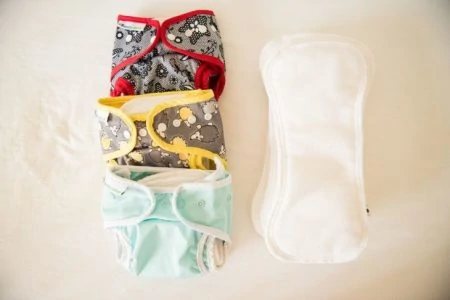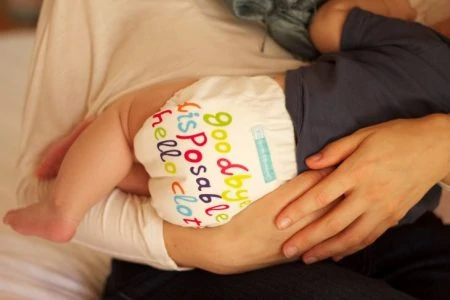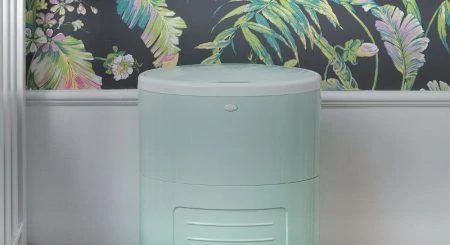Have you considered cloth diapers but been deterred by the initial expense? Do you find yourself currently strapped for cash while you’re facing all the expenses pregnancy can create?
While many moms opt for cloth diapers to save money, the unfortunate truth remains that it is expensive in the beginning to buy an adequate supply of diapers.
The good news is that the cost of cloth may still be in reach, thanks to cloth diaper banks. We have the answers to all your questions about cloth diaper banks, including what they are, how to find them, and how to save money by accessing them.
Key Takeaways
- Cloth diaper banks help low-income families access cloth diapers for free or at a low cost, reducing financial burden and promoting child health.
- Used cloth diapers are safe if properly cleaned and sanitized, often available through diaper banks or by purchasing second-hand.
- Find a cloth diaper bank near you by searching online or checking out organizations like Share the Love, GroVia Gives, and One Diaper Canada.
- If a diaper bank isn’t available, save money on cloth diapers by buying used, asking local Buy Nothing groups, or registering for diapers as baby gifts.
- What is a Cloth Diaper Bank?
- How Do Cloth Diaper Banks Help Families?
- Isn’t Cloth Diapering Cheaper Than Disposable Diapers?
- Are Used Cloth Diapers Safe?
- How Can I Find a Cloth Diaper Bank Near Me?
- How Do I Access Cloth Diaper Banks?
- How Can I Save Money on Cloth Without a Diaper Bank?
- How Can I Support Cloth Diaper Banks?
- FAQs
- The Bottom Line
What is a Cloth Diaper Bank?
A cloth diaper bank is an organization that provides free cloth diapers, either on loan or to keep, to low-income families who don’t have the means to finance the start-up costs associated with cloth diapering.
How Do Cloth Diaper Banks Help Families?
There are no public service programs that help needy families with the cost of diapers. A family’s struggle with this financial burden is known as “diaper need.” Since assistance is sorely lacking, mothers have unfortunately had to get creative to stretch their limited dollars as far as possible.
Sadly, for some, this means going longer than recommended between diaper changes, airing out wet diapers for re-use, and even scraping out excrement so their child can wear a diaper longer (1). These measures can result in serious health problems for children, including urinary tract infections and wounds, and mental health problems for parents.
Why It’s Important
Isn’t Cloth Diapering Cheaper Than Disposable Diapers?
Parents spend up to $900 per year on disposable diapers per child — and that doesn’t include the cost of wipes and butt creams (2). Using cloth diapers can yield significant lifetime savings. However, it can cost around $300 to purchase an initial stash of cloth diapers to diaper your child adequately.
For many families, that upfront amount is cost-prohibitive and makes it impossible to consider cloth diapering, even though they know they’d save money in the long run.
Cloth diaper banks fill this gap by providing financially struggling families with access to cloth diapers without the huge initial expense.
Are Used Cloth Diapers Safe?
While some diaper banks provide new cloth diapers, most are previously used and refurbished, making many parents wonder if they’re safe to use.
Rest assured, with proper cleaning, second-hand cloth diapers are perfectly sanitary and safe to use. Most will arrive ready to use, but if you want extra assurance they are indeed clean, you can bleach and strip your diapers upon arrival.
Check the manufacturer’s instructions that accompany your diapers, but the general procedure for stripping diapers is:
- Load diapers into your washing machine.
- Add ½ cup of bleach and 1 tablespoon Dawn blue dishwashing liquid.
- Run your washer on the hottest cycle available.
- Run the rinse cycle 2-3 more times until no suds are visible while agitating. If your washer does not have a standalone rinse cycle, just rerun the wash cycle without soap.
- Dry your diapers: Inserts go in the dryer with no fabric softener, while covers should be set out to air dry.
- Depending on the weather, you can take the added step of sunning your diapers, which involves setting them out in direct sunlight for several hours. This not only kills yeast and other bacteria but also helps remove poop stains.
How Can I Find a Cloth Diaper Bank Near Me?
If you’re interested in cloth diapers but are unable to afford them, a cloth diaper bank may be able to help — either by giving you an initial stash or providing you a supply on loan. The following organizations provide cloth diapers to families in need:
Share the Love
Share the Love was launched in 2012 by the CEO of Cotton Babies, a cloth diaper company. She had personally struggled with the cost of diapering and discovered cloth diapers as an affordable way to diaper her child.
Share the Love is passionate about making cloth diapers accessible to those who need them most. They have locations throughout the U.S., and while applications are accepted online, approved applicants must pick up their diapers at one of the host sites or pay a small shipping and handling fee to receive their diapers by mail.
Website: http://www.cottonbabieslove.com/
GroVia Gives
Grovia is a cloth diaper company that also runs a lending program for families in need. Families are charged a nominal lending fee, which includes the cost of shipping, and receive diapers that will fit babies that weigh 10-35 pounds.
Applications are taken online, and diapers are shipped directly to approved families. This program is only available to U.S. applicants.
One Diaper Canada
Headquartered in Ottawa, Ontario, One Diaper Canada’s goal is to help alleviate financial need by providing complete cloth diapering kits to families in need. The kits include inserts, covers, liners, detergent samples, and other cloth diapering necessities.
One Diaper Canada works with local social service providers to identify recipients throughout Ottawa and the surrounding region, but they also accept applications online.
Website: http://onediaper.org/
Facebook: https://www.facebook.com/onediapercanada
Cloth for a Cause
Cloth for a Cause was launched in 2011 by a single mom in British Columbia and now has chapters throughout Canada. They are a non-profit organization run by volunteers who sanitize, sew, and refurbish used cloth diapers for distribution to families in need.
All diapers are loaned and should be returned after use. Applications are accepted online, and applicants are connected with a local chapter to receive education about how to cloth diaper successfully.
Website: https://clothforacause.org/
Babies in Cloth
Babies in Cloth is based out of Alberta, Canada, and has many chapters throughout the area. Their mission is to help families with the rising costs of childrearing by collecting and loaning used cloth diapers.
Applications are available on their website.
Website: http://abbabiesincloth.weebly.com/
While these are larger organizations, many smaller cloth diaper banks serve local municipalities. Simply do a web search and see what comes up near you.
How Do I Access Cloth Diaper Banks?
While each cloth diaper bank has different lending criteria, most have initial online applications. If you’d like to apply, do the following:
1. Check the eligibility criteria.
Before you apply to an organization, first read through their eligibility criteria and, if applicable, their lending agreement. That will help ensure you are eligible and willing to participate in their required activities.
2. Check the service area
Also, check the organization’s service area to ensure your location is eligible to receive services.
3. Gather the necessary documentation.
Most organizations require some level of documentation to apply for their programs.
These may include:
- Proof of pregnancy/birth certificate to prove age.
- Proof of residency.
- Income verification.
- Documentation of public assistance.
Check the requirements of your preferred agency and gather the necessary documents before applying. If you need to submit electronic proof of a paper document, you can often create a digital scan at your local library or simply take a photo of it with your smartphone.
4. Apply online.
After you’re organized and have all the information you need, fill out the online form.
5. Check your junk e-mail.
After submitting your application, check your email for a response — most respond within a few days. However, it’s not uncommon for emails to be filtered into your spam folder. Watch that folder closely until you get your response.
How Can I Save Money on Cloth Without a Diaper Bank?
If you find yourself without a cloth diaper bank available, it doesn’t mean cloth diapering has to remain out of reach. There are several other ways to get cloth diapers for free or cheap, including:
1. Buy Used Cloth Diapers.
There are several places to buy used cloth diapers for much less than you would buy them new. Retailers tend to charge more than private party sellers, but they often guarantee the condition of their products.
You can buy secondhand cloth diapers at places such as:
- Baby/child consignment stores.
- Jillian’s Drawers.
- Diaper Junction.
- Cotton Babies Seconds Sale. (new products with minor imperfections)
2. Buy Private Party.
Many mothers, myself included, finish cloth diapering their children and want to recoup some of their initial costs. Buying directly from a mom is a great way to cut out the middleman and extra costs and score an entire lot at an amazing price.
You can find great deals on:
- Craigslist.
- OfferUp.
- eBay.
- Facebook Market Place.
3. Ask Your Local Buy Nothing Group.
The Buy Nothing Project has exploded in recent years, and most areas have a local gifting community, typically housed on Facebook. Join your local group and ask if anyone has cloth diapers they’re no longer using and would be willing to gift.
Then, give back to your local community by passing on some of the things you’re no longer using.
4. Register for Diapers.
There’s a lot of stuff you don’t really need for a baby, like fancy bedding, a diaper warmer, and twenty newborn outfits. Pare down your baby registry of the non-essentials and instead register for cloth diapers.
Most popular retailers carry cloth now that they’re so mainstream, but many cloth diaper companies also run their own registry if there’s a brand you’ve got your heart set on.
And if you opt for less expensive brands, you’ll be able to get more diapers on your registry than if you go for the expensive brands.
How Can I Support Cloth Diaper Banks?
Most of the above-listed organizations accept cash and used cloth diaper donations if you’d like to help support cloth diapers for families in need. You can also see if a smaller diaper bank in your area accepts used cloth diapers, or you can simply gift your old diapers to someone in your community.
FAQs
The Bottom Line
If you struggle with diaper need, choosing cloth may help cut the overall cost of diapering your child, but the start-up costs can be expensive.
There are several ways to access cloth for less than full price, including:
- Applying through cloth diaper banks.
- Buying from secondhand retailers.
- Buying used diapers from a private party.
- Asking your local Buy Nothing group.
- Registering for cloth diapers and supplies.










